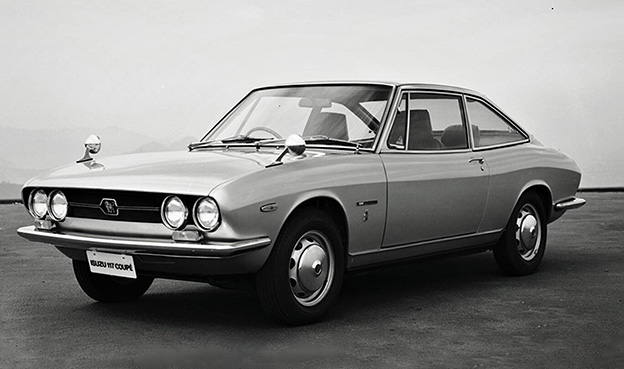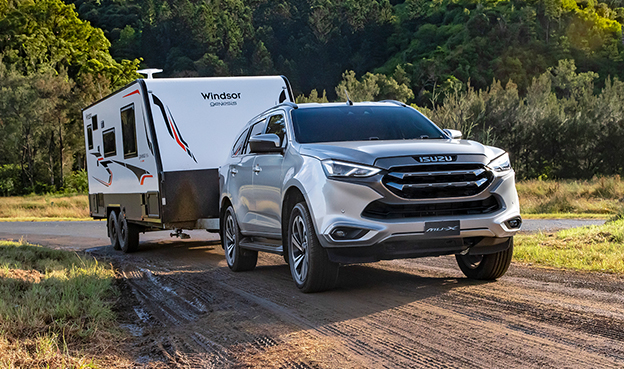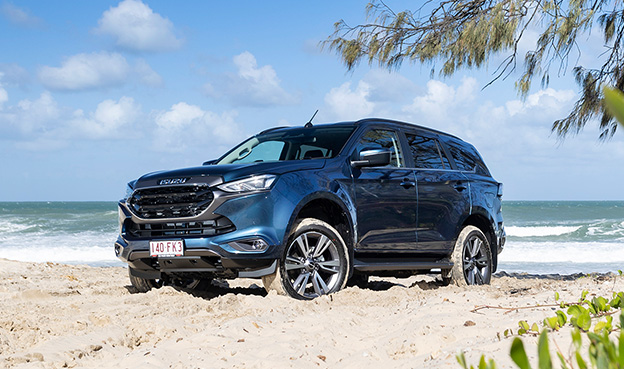

Isuzu’s life-saving Intelligent Driver Assistance System◊ (IDAS) technology is available across the range—but what does it all mean?
“IT’S NO FLUKE that the third-generation D-MAX was the first ute in Australia to earn a five-star rating under ANCAP’s new, more stringent safety criteria,” says I-Venture Club trainer Matt Taylor. “And IDAS is a crucial part.” “The best thing? IDAS is standardised across the new-generation MU-X range too.”
Isuzu’s IDAS◊ tech might appear to be an alphabet soup of acronyms, but put together, it’s an intuitive array of systems built to monitor the world around you. It can react instantly to prevent accidents … or, in less dramatic circumstances, just to make day-to-day driving (and parking) safer and easier. Here’s a list of some key features—explained in easy-to-understand language.
BLIND SPOT MONITORING (BSM)
BSM provides a two-stage warning. First, an amber light appears if a vehicle is in your blind spot. Then if the driver uses the indicator—i.e. they’re going to turn—the light flashes to provide extra warning.
FORWARD COLLISION WARNING (FCW)
Using the IDAS◊ stereo imaging cameras to keep a constant eye on the road ahead, FCW warns the driver both visually and audibly if it detects a potential collision ahead.
AUTONOMOUS EMERGENCY BRAKING (AEB) WITH TURN ASSIST
IDAS◊ stereo imaging cameras have a really wide field of vision, which they use to detect oncoming vehicles when you’re preparing for a turn. So if you begin to turn into the path of oncoming traffic, it can intervene.
ADAPTIVE CRUISE CONTROL (ACC) WITH STOP AND GO
Simply set your maximum speed and the following distance, and the ACC will adjust accordingly to the car in front—it even works in stop-start traffic!
LANE KEEP ASSIST (LKA)
With Adaptive Cruise Control engaged, Lane Keep Assist detects lane shoulder markings. Then it provides gentle steering assistance, which you can feel, to keep the vehicle centred in its own lane.

TRAFFIC SIGN RECOGNITION (TSR)
No need to second guess what the speed limit is. The TSR automatically displays the last detected speed limit sign for easy, immediate reference.
MISACCELERATION MITIGATION (MAM)
This is handy in, say, parking stations. When you’re travelling slowly in confined spaces, if the accelerator is accidentally applied and a potential impact is detected ahead, MAM will suppress that input.
EMERGENCY LANE KEEPING (ELK)
During lane changes, whether they’re intended or accidental, if a vehicle is detected coming from behind in the adjacent lane, ELK offers visual and audible warnings to the driver before providing steering assistance to avoid a collision.
LANE DEPARTURE WARNING (LDW)
LDW can warn the driver if their vehicle starts to stray out of its lane. First it uses a visual warning in the Multi Information Display beside the speedo, then with haptic vibration through the steering wheel.
AUTONOMOUS EMERGENCY BRAKING (AEB)
If the driver fails to respond to the Forward Collision Warning (FCW), the system can react with suitable emergency braking to mitigate or prevent the impact. It basically applies the brakes independently if for some reason you don’t!

LANE DEPARTURE PREVENTION (LDP)
If the driver fails to respond to the LDW, and they’re about to stray out of their lane, the system can automatically react with a warning and then steering assistance to pull them back into line.
TRAILER SWAY CONTROL (TSC)
This is a fine-tuned element of the ESC. It can detect the early signs of trailer sway and it will suppress engine power while strategically applying individual brake force to individual wheels to help straighten the vehicle—and your trailer—to keep you in line.
REAR CROSS TRAFFIC ALERT (RCTA)
It’s often difficult to see passing traffic while reversing out of a tight park, so RCTA uses rear-mounted radars to detect any such obstacles. Then it provides both a visual and auditory warning if a collision is on the cards.
INTELLIGENT SPEED LIMITER (ISL)
The speed limiter function can intelligently adapt to the last detected speed limit at the push of a button. Toggle it and it’ll respond on request, which is perfect for driving through road works and school zones.
KNOWING WHEN TOWING
IDAS◊ knows when you’re hitched up, and will automatically turn off the Reverse Park Assist Sensors when you’re backing up your van. When towing, it is recommended that you toggle off several IDAS◊ features that otherwise would intervene: Lane Departure Prevention (LDP), Emergency Lane Keeping (ELK), Lane Keep Assist (LKA), Adaptive Cruise Control (ACC), Blind Spot Monitor (BSM), and Rear Cross Traffic Alert (RCTA).
TIP: you can quickly toggle some features on or off via the MID or, in models 22MY onwards, via the Lane Support Setting switch on the steering wheel.





